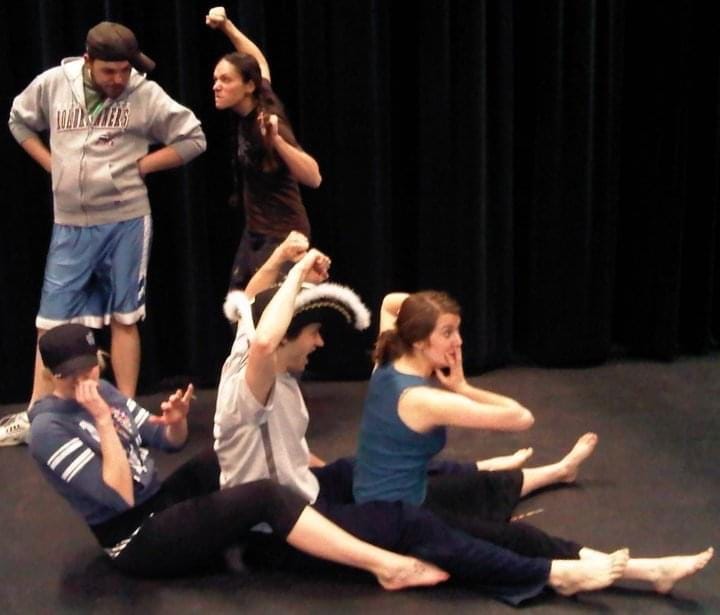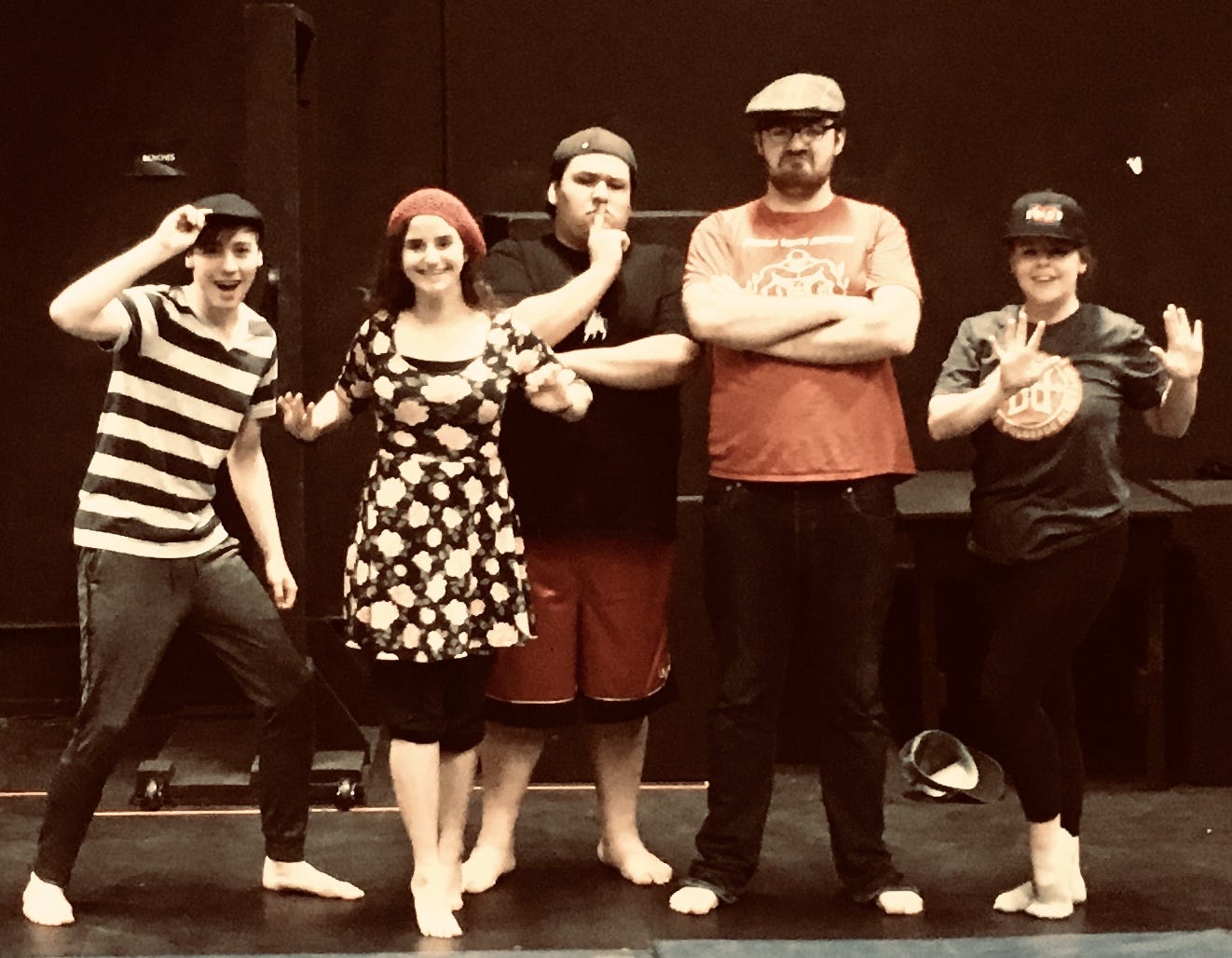Clownlympics
~a vocab word that I conglomerated myself, for convenient use in movement class when dealing with a bunch of clowns.
And now… the CLOWNLYMPICS!
This is a word I made up myself, the first time I placed more framework onto the clowning unit of my college-level Stage Movement class. Before this curriculum change, the students learned clowning techniques and then were set free to concoct a fresh gag, on their own or in a group. That’s it.
Well of course, as anyone who’s ever had any iota of clowning experience can tell you, it’s a pretty high-skill ask to just create a good quality clown gag from scratch, especially when one is young and has had a total of six hours of class time on it plus a little research, only. I’m lucky enough in my own training that I had a robust clowning unit in my high school drama class, spanning a good amount of time, headed by a guest artist professional and culminating in at least one hour straight of clowning on the Pearl St Mall as a final exam for the unit.* Also that I, at 16 years old and obsessed with being a court jester in real life, took a summer intensive from none other than Bill Irwin himself. And, yanno, afterwards took gigs and things. These kids had a slightly distilled and of course very condensed overview of how to clown, as much as I force viewings of the greats unto them constantly ( which is a much easier thing to do in recent times than it was back when I first started teaching this course, before everything got put on YouTube).
*I got a very high compliment from this pro, after she’d seen me perform as Smee in our high school production of Peter Pan, which I remember to this day. She said: “You were amazing! Have you ever done any clowning before?” When I said no, she exclaimed: “You looked like a professional clown up there. I’m serious.”
So very early on, I decided to change the focus of the clowning unit of this class, and limit the clown performers’ final choices to: a sporting event. That’s it. And they’re always in groups, now, so nobody’s forced to come up with this challenge alone. But! To get an A, each clownlympics event should include everything a “normal” clown gag does:
a problem with an elaborate solution;
a beginning, middle, and end;
distinct exaggerated clown characters (complete with self-chosen clown hat),
no props but your character hat—all objects, set pieces, etc. must be created by physicality only;
no verbals, only vocals;
and, well:
Funny.
But that last isn’t what I actually talk about when I teach clowning. Not usually. I consider the word (“funny”) almost sort of taboo when talking about the art—I just show the students a bunch of examples, from incredible gymnast Paul Hunt [1] to rubber faced Rowan Atkinson [2]; postmodern genius clown Bill Irwin literally fighting his critic [3] (this particular bit begins at around 9:31), to a classic Charlie Chaplin gag [4], valiantly holding his own in the boxing ring against an ogre. Often I’ll show them the devastatingly simple Monty Python footrace [5], the 1980s SNL All-Drug Olympics (CONTENT WARNING: so much blood. Hilarious blood). [6] And finally, now that you can find anything and everything on YouTube, I’ll show them the Master himself at work, Marcel Marceau [7] as iconic mime clown character Pip. I describe for my students after each clip the skill involved in the physical acts they see, and I reveal the structure of each piece.* The students figure out what makes all these bits and gags work, or, if they don’t think they do, what’s missing. And of course, we’re all laughing, the whole time.
*Find a version of this for you, tuition-free, in the endnotes below. Yer welcome.
The Clownlympics are always fantastic—so many creative ideas: a cheerleading demo with a lopsided pyramid as a spectacular climax; a bowling match wherein the ball got away from each clown in turn, in different ways; and a gargantuan, Agincourt-level pie fight. Other sports represented have included: a footrace that ended with celebratory slo-mo and a Chariots of Fire soundtrack; a bass fishing contest gone hilariously awry. And of course, a solemn closing ceremony: an Olympic-style medal distribution with gold, silver, and bronze winners perched atop clowns on all fours or the floor to put them at the proper height.

One other thing I like to do is bring in the panoply of dance class instruments I inherited from my mother the dance teacher, and have the audience accompany each act with drumrolls, toots, jingles, and percussive melodies to reinforce each physical punctuation. It’s dear, and fun, and childlike, and rather grand (as all things that are all those things are).
What I do NOT do, is clown makeup technique. We do learn the basic looks when we learn about the various types of clown, but we don’t do the actual makeup in class, as that’s not the point in a course about movement. Also, yanno, budget. But mainly it’s just a distraction from the core discipline. Clowning isn’t first about the makeup, anyway—just look again at Bill Irwin (or Rowan Atkinson) to see what I mean.
[1] The thing that makes this act so brilliant is: Hunt isn’t making fun of women’s events, though his silly costume and his discomfort in it makes us question the gendered outfits that are the norm in the sport. But mainly: what an incredible athlete he is, to be able to do this stuff “badly.” That final landing is a REALLY good stunt fall—like, really good! Hunt does all the women’s gymnastic events, so I recommend searching for his work: his balance beam bit is equally amazing to this one.
[2] Rowan Atkinson is one of the two best virtuoso clowns in modern times. (The other I talk about next). His brilliance in this bit in particular resides in his mime talents: he gives the invisible objects a physical presence on that stage. His facial expressions and focus make the illusion complete. Any of his Mr. Bean work is great clowning, but I tend to prefer his pre-Bean live performances, like this one and the one where he’s playing a silent proto-Bean struggling to adult in church.
[3] This sharp genius revolutionized modern clowning, and I am honored to have learned directly from the source. He began with this intelligent clowning commentary onstage in the ‘80s and ‘90s, then moved on to physically comedic roles in TV and film (one of his most famous being Mr. Noodles from Sesame Street), and now is doing high-level live theatre again, like Waiting For Godot and one-man shows.
[4] When assigning a clown sporting event, I of course must show this scene from City Lights, which is so phenomenally choreographed, I can’t hardly stand it. I always show this to my stage combat students, too.
[5] Short, sweet, simple. Brilliant.
[6] Another short, sweet, simple bit that centers in the spectacular physical punchline. I like this one (though its verbal component doesn’t fit the assignment parameters) because we get so much build up in the sporting commentary that increases in its dramatic tension, that by the time the big movement and special effects bit happens, it’s perfect timing. Also, the handlers that come up and dab the weight-lifter’s dangling bloody tendons with a towel is excellent clowning.
[7] Mimes get a bad rap these days, and tbh I have no idea why. So I show my students some of the Master’s work—I tend to choose this Mask-Maker bit because it’s beyond amazing how Marceau isolates his frozen mask-face from the rest of his body. The moment when he is obviously crying, after having frantically tried to take the mask off, and his face is no different, even as the rest of his body is wracked with silent sobs? Amazing. Isolation is a central skill for mime and other forms of physical characterization and comedy, and this bit is a prime example, performed by a master.
All pics come from MSU Denver’s stage movement class under my instruction, 2017 thru 2019.





